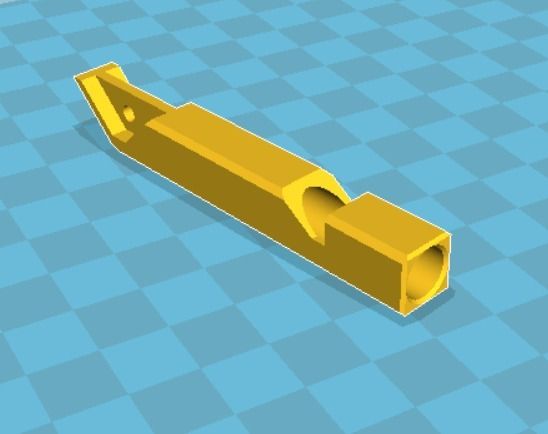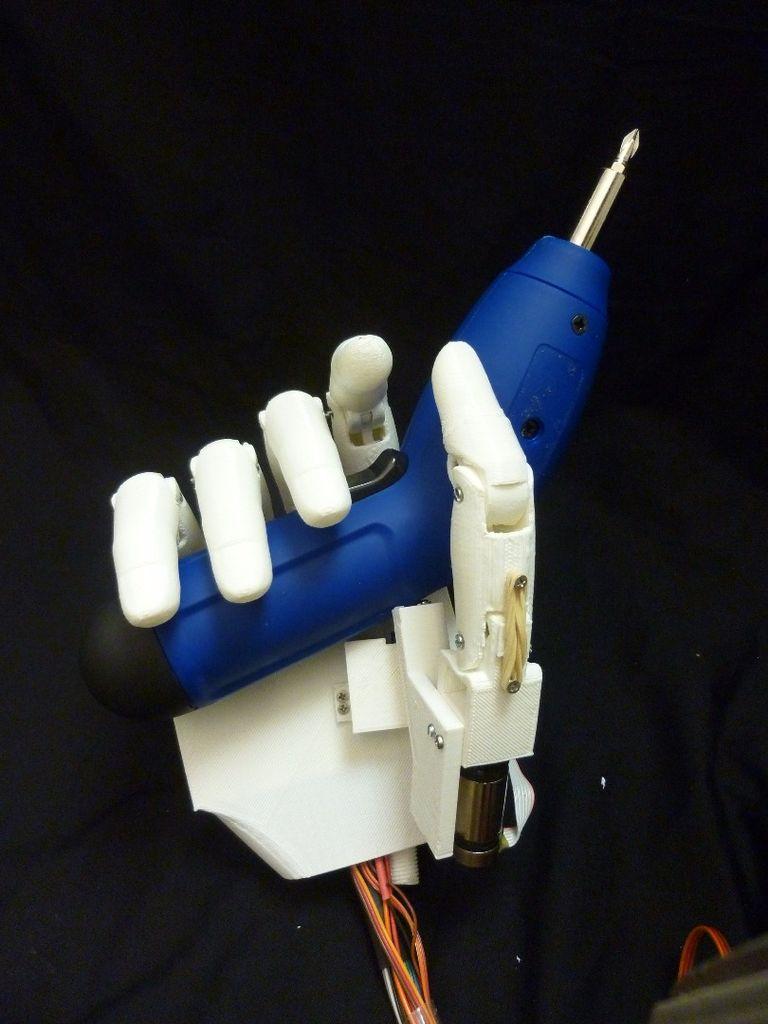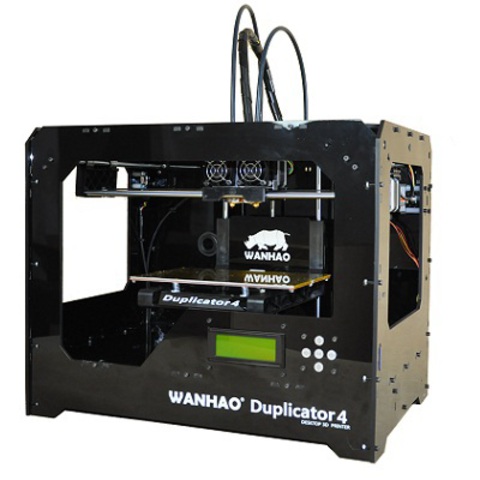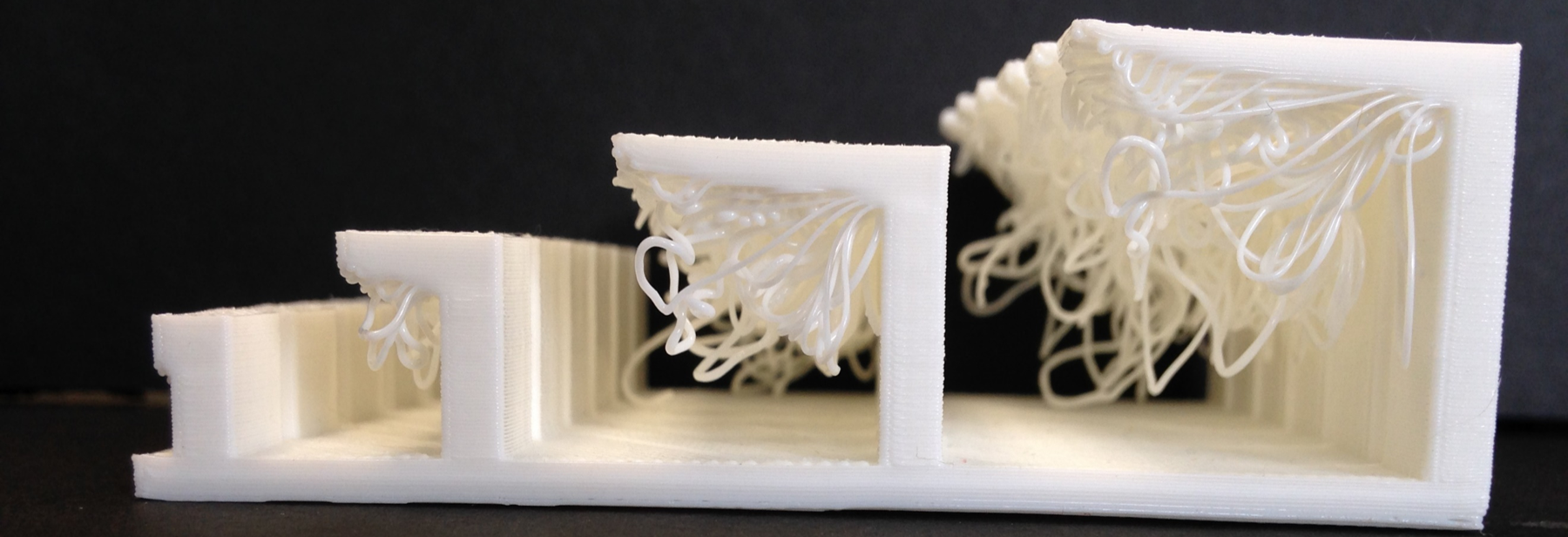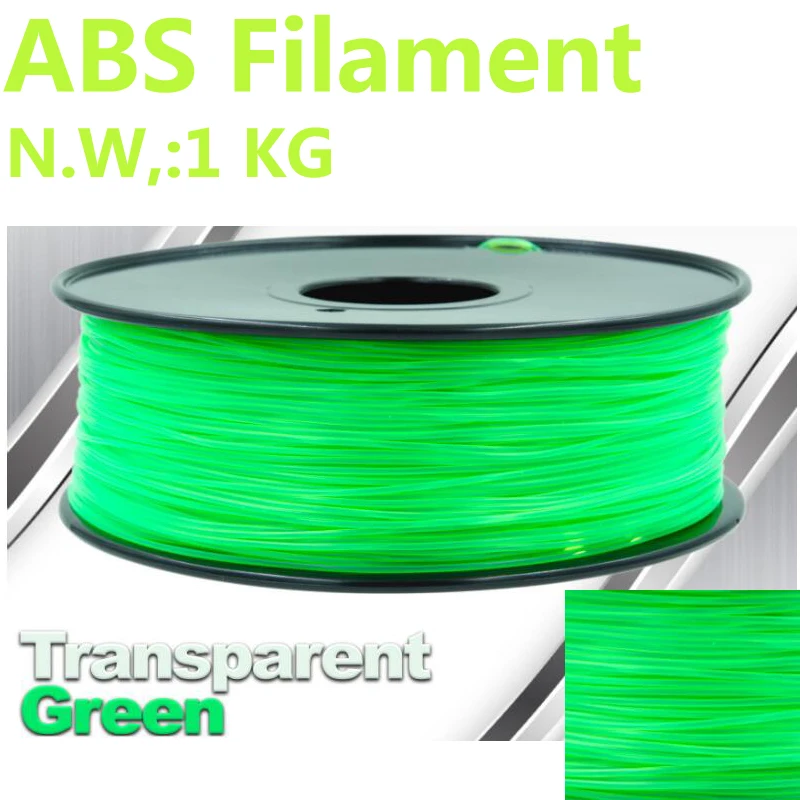3D digital scanner
How to Choose the Best 3D Scanner to Use With Your 3D Printer
3D scanning has an important place at the beginning and end of 3D fabrication workflows. Engineers, product designers, and researchers use 3D scanners as a faster and more efficient way to start constructing digital models, whether by incorporating existing designs via reverse engineering, digitizing hand-sculpted clay designs, or referencing the exact shape of the human body.
After fabrication, 3D scanning can support quality control and help to verify the accuracy of a 3D printed part, or, after the part has been used, a scanner can reveal how it’s performed—a scan of a deformed part can show you where to reinforce the design in the next revision.
With such a wide range of product options from handheld 3D scanners to desktop 3D scanners, it can be difficult to choose the best 3D scanning system that’s right for your application and budget. In this post, we explore the most important factors to consider when purchasing a 3D scanner and showcase some of the key applications that are empowered by combining 3D scanning and 3D printing.
White Paper
3D scanning and 3D printing workflows can be applied to replication and restoration, reverse engineering, metrology, and more. Download our white paper to explore these applications and learn how to get started.
Download the White Paper
There are multiple scanning technologies currently on the market, all offering their own advantages and weaknesses.
Laser triangulation uses light projected onto the object to take up to millions of measurements (dots) per second. The light reflected from the dots back into the scanner’s sensor to help it capture the geometry of the object. These types of scanners are often the most accurate, and are great for highly detailed parts that have opaque surfaces.
Laser triangulation scanners do have limitations. For example, this technology is not used in most portable scanners because the laser dots need to project from a stable source, and the source has to be kept a close distance from the scanned object.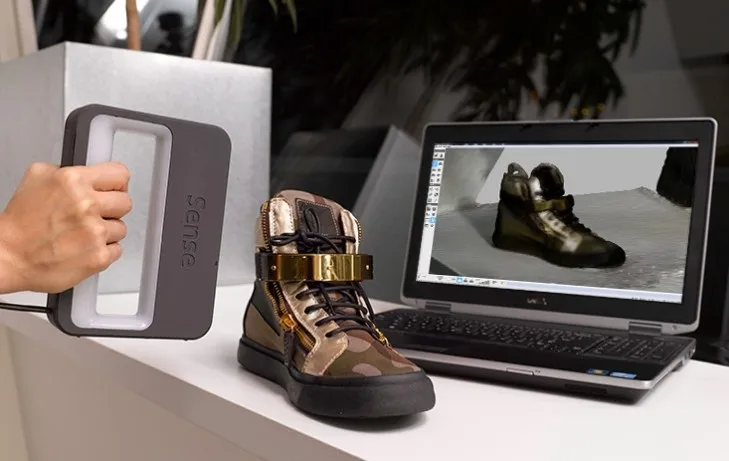 Laser triangulation scanners don’t always work on transparent or shiny surfaces either. Typically, they require reflective markers to be applied onto the object, which need to be removed after use and can be an obstacle depending on the object being scanned.
Laser triangulation scanners don’t always work on transparent or shiny surfaces either. Typically, they require reflective markers to be applied onto the object, which need to be removed after use and can be an obstacle depending on the object being scanned.
Finally, the laser dots can be harmful to human eyes, so it is important to use extra safety precautions when scanning body parts with a laser triangulation system, or to check with your scanner manufacturer to make sure the device is eye-safe.
Structured light scanners (also known as white light scanners or blue light scanners) generally use a projector with two cameras at angles on either side. A pattern of light is projected and laid over the component being scanned, the cameras capture the ways in which the object deforms the light pattern, and then multiple images are integrated into a single 3D snapshot.
Structured light scanners are available in both stationary and portable format—the technology is the most commonly used process for handheld 3D scanners. Structured light scanners are far more common in medical applications, since it is safe to use on both humans and animals and excels when an object is not perfectly still. Traditional white light scanners have been slower to scan than laser triangulation scanners.
Structured light scanners are far more common in medical applications, since it is safe to use on both humans and animals and excels when an object is not perfectly still. Traditional white light scanners have been slower to scan than laser triangulation scanners.
Structured light scanning is the most commonly used technology in handheld 3D scanners.
Depth-sensing cameras project a field of dots in infrared (IR) to sample a 3D scene. Depth-sensing cameras are simple to use and are the least expensive scanning option, but their accuracy and resolution are low, and fine details are sometimes lost. Large objects may be captured with depth-sensing cameras, but accuracy declines with increased distance from the subject and at steeper angles to the camera.
Photogrammetry means the act of deriving precise measurements from photographs. It involves taking a set of overlapping photos of an object, building, person, or environment, and converting them into a 3D model using a number of computer algorithms. This is the most commonly used method when creating a 3D scan with a smartphone, since modern phone cameras are capable of capturing and combining a large numbers of photos. Photogrammetry should be considered the least expensive and least accurate method for creating 3D prints, and is not suitable for serious business applications.
This is the most commonly used method when creating a 3D scan with a smartphone, since modern phone cameras are capable of capturing and combining a large numbers of photos. Photogrammetry should be considered the least expensive and least accurate method for creating 3D prints, and is not suitable for serious business applications.
LiDAR (light detection and ranging) sensors can be found on some higher-end smartphones and tablets, such as the latest versions of the iPhone Pro and the iPad Pro. This has made the iPhone and iPad viable scanners for those with only occasional scanning needs, offering performance a step above devices that only have access to photogrammetry. Applications that generate 3D mesh files via your smartphone’s or tablet's camera should be seen as the floor for entry-level scanning; users should expect additional work in their CAD software to remove gaps in meshes and improve the 3D model for applications like sending it to a 3D printer. Smartphones use fewer light points when scanning objects, resulting in less detail than a true, stand-alone scanner.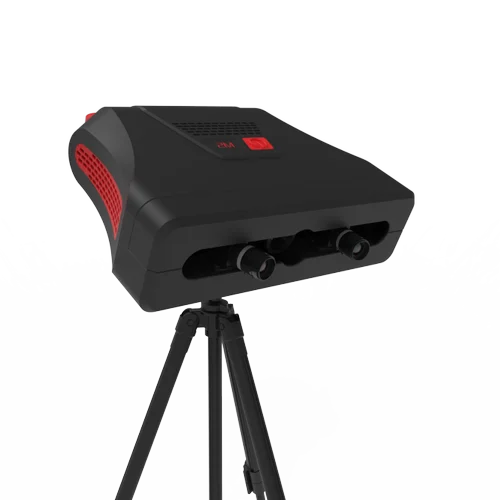 iPhones are good substitutes for scanners if you have significant CAD design ability or need to transfer basic models into a digital space.
iPhones are good substitutes for scanners if you have significant CAD design ability or need to transfer basic models into a digital space.
WEBINAR
Watch this webinar with Peel 3D to explore how to integrate 3D scanners into your 3D printing workflow to elevate your product development process.
Watch the Webinar Now
Scan accuracy varies considerably between scanner technologies, and higher accuracy generally comes at a higher cost. The required tolerances of your final part can be a helpful guide for determining your accuracy requirements for a 3D scanner.
| High Price, Highest Accuracy ($15,000 and more) | More Affordable, High Accuracy ($12,000 and under) | Low price, Low Accuracy |
|---|---|---|
| Zeiss T-Scan Hawk Scantech Simscan EviXscan Optima+ M Creaform HandyScan 307 Silver Series | peel 3d peel 1, peel 2 & peel 2-S FARO Freestyle 2 Polyga Compact S1 | iPhone Pro and iPad Pro Structure Sensor Matter and Form 3D Scanner V2 Revopoint POP |
With accuracy in the range of 0. 1 mm or better, laser and structured light scanners are a good fit for professional applications and alongside high-resolution 3D printers. Formlabs stereolithography (SLA) 3D printers (such as the Form 3+) produce parts at a similar accuracy, and with a similar printable area, to the scan volume of many desktop 3D scanners.
1 mm or better, laser and structured light scanners are a good fit for professional applications and alongside high-resolution 3D printers. Formlabs stereolithography (SLA) 3D printers (such as the Form 3+) produce parts at a similar accuracy, and with a similar printable area, to the scan volume of many desktop 3D scanners.
Besides the accuracy between measured points and their actual location, scanners also vary in terms of resolution, which is the distance between captured points at a given scan distance. This means that details on the scanned object that are smaller than the scanner’s resolution won’t be captured. For example, a highly accurate 3D scanner with a lower resolution might detect the general shape of jewelry on a statue, but not clearly show individual details on a ring or necklace. Depending on your project requirements, this may or may not be a dealbreaker.
An easy way to remember these metrics is: accuracy is the measurement error between the part and digital value.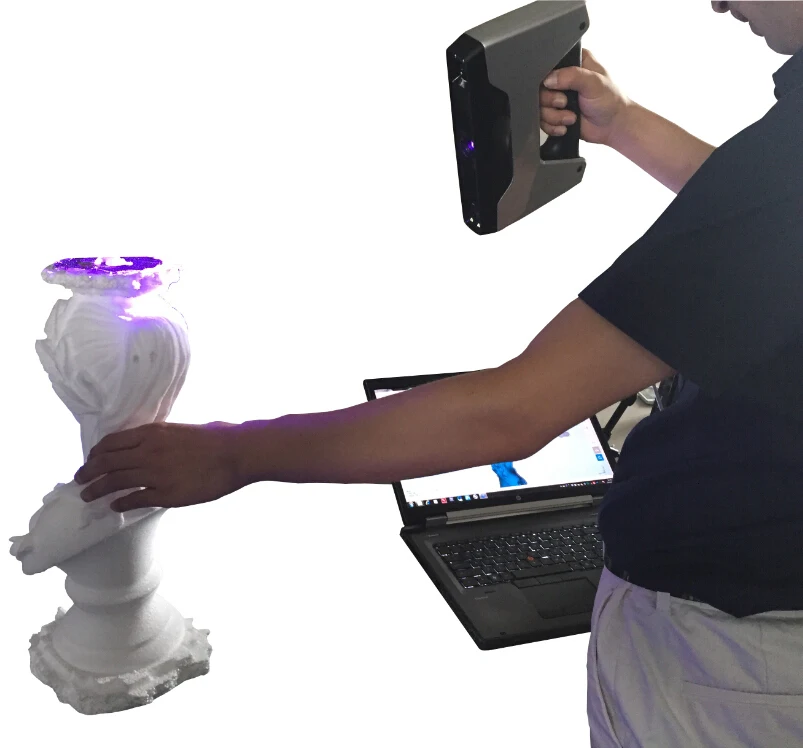 Resolution refers to the density of measurements.
Resolution refers to the density of measurements.
Accuracy can mean slightly different things depending on the manufacturer and 3D scanning technology. For example, the accuracy of handheld scanners depends on the distance to the subject and the quality of scan reconstruction, while desktop scanners have consistent accuracy within the constrained scan volume. If you are considering buying a 3D scanner for precise measurement, make sure to compare like to like.
In general, structured light scanning provides the best resolution and accuracy when compared to laser scanning. For some artistic use-cases for 3D scanning you may need a lot of detail, while overall accuracy is less important—especially if you don’t require your part to fit precisely with other parts in an assembly. In these cases, photogrammetry is an excellent low-cost option to explore.
Both depth-sensing cameras and photogrammetry are a good solution for scanning large objects in order to create 3D printed scale models and also offer enough accuracy for capturing the shape of the human body.
Several entry-level laser scanners are available using technology similar to higher-end systems. These scanners are a great way to start replicating small objects at 1:1 scale. As one would expect, the accuracy of entry-level laser 3D scanners is lower than a high-end scanner, but they can easily provide enough detail to replicate small decorative objects and figures where accuracy is not critical.
If you only have occasional 3D scanning needs, digitization services can scan your object, as well as perform CAD translation and accuracy inspection.
The area that a 3D scanner can capture varies significantly between scanners. Find a scanner that fits your size and resolution requirements without too much overhead, as cost typically increases with scan volume.
Handheld scanners can be manually moved around the object and have fewer size constraints than desktop models. Most inexpensive handheld scanners can capture objects from the size of a basketball to an entire room.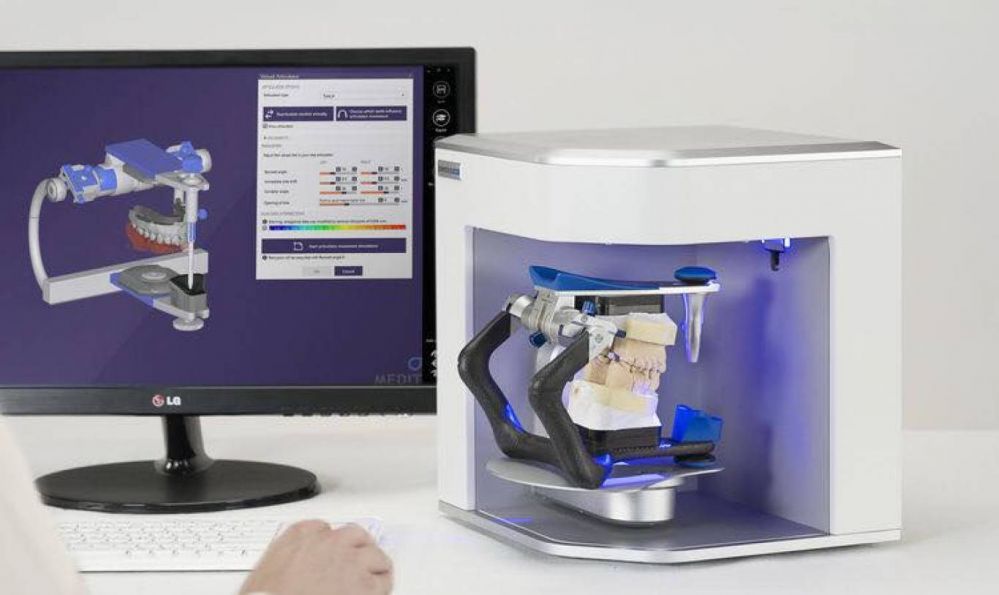 High-end handheld scanners have an even wider range, and fill the niche for all objects that require precise measurements, but cannot fit in a desktop scanner. Handheld scanners are also able to capture objects nearly instantaneously, which makes them well-suited for taking human measurements (where the subject is not perfectly still) for ergonomics and medical applications.
High-end handheld scanners have an even wider range, and fill the niche for all objects that require precise measurements, but cannot fit in a desktop scanner. Handheld scanners are also able to capture objects nearly instantaneously, which makes them well-suited for taking human measurements (where the subject is not perfectly still) for ergonomics and medical applications.
If the area of the model can’t be seen by the scanner, it will cause a gap in the model. You can automatically repair small missing sections with most scan software programs to create a 3D printable model. However, repaired holes are rarely accurate to the original object. For parts that demand close to perfect accuracy, auto-repair of gaps or holes will not be sufficient. Read our MeshMixer tutorial for advanced tips to edit and repair 3D files for 3D printing.
Many scanners use turntables to increase what the scanner can see. The sophistication of a scanner’s turntable affects how easily and completely the object is captured: some scanners have the ability to move the object around multiple axes, imaging the object from more angles.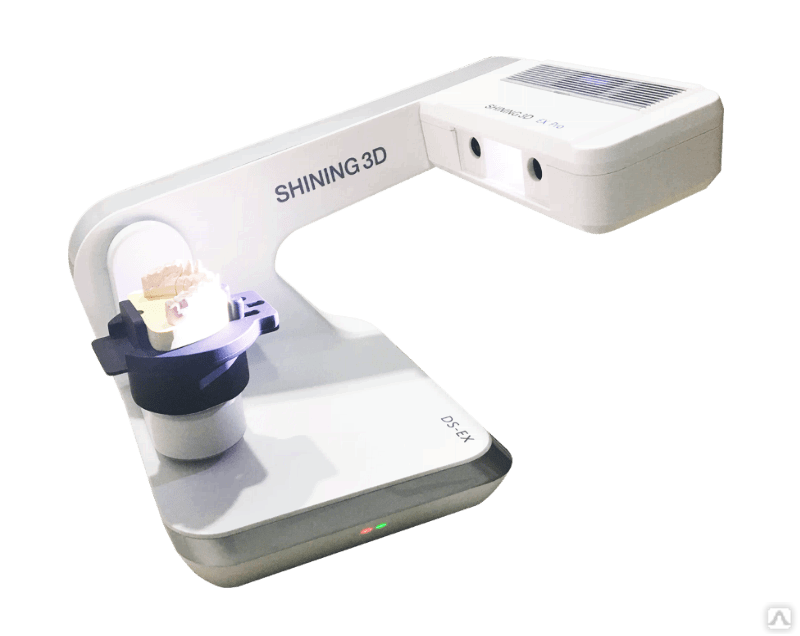 This feature is important when reverse engineering plastic parts with deep recesses and ribs, which are impossible to capture from a single angle.
This feature is important when reverse engineering plastic parts with deep recesses and ribs, which are impossible to capture from a single angle.
Scanners may rotate the object to capture occluded areas. Red regions are occluded and will be missing in the scan. Areas with deep relief are difficult for a single axis turntable to fully capture due to occlusion.
Cost concerns are straightforward; how much you are willing to spend on a scanner will reflect your business’s budget and how often the scanner is going to be used. Higher cost scanners will be able to capture small objects and create highly-detailed meshes that don’t require significant touch-ups in CAD software. Handheld scanners are also often on the higher end of the price range, due to their portable nature. The low-cost scanning market offers a wide range of options, but you have to know what to look for.
Use this flowchart to determine what scanner you need based on accuracy, scan volume, and budget.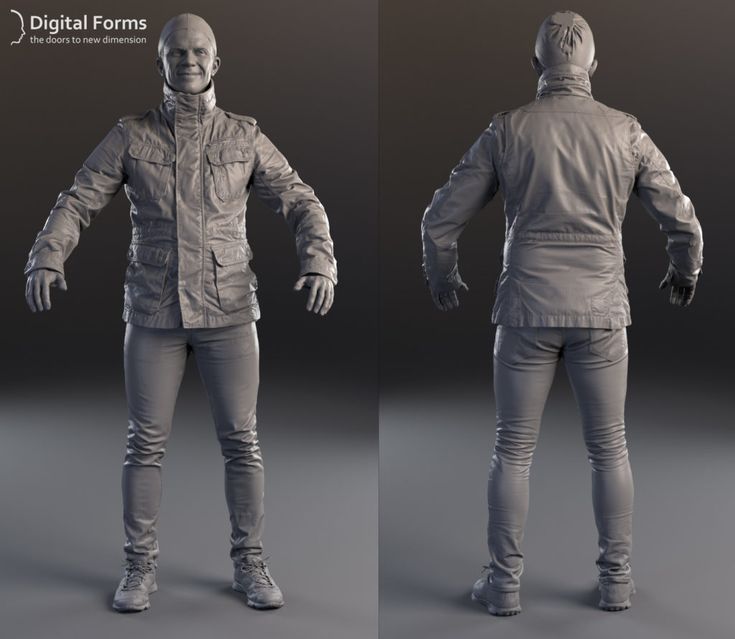
Download the high-resolution version of this infographic here.
A 3D scanner expands the capabilities of a 3D printer, allowing you to replicate the shape of almost any object. Together, the two technologies create a powerful, digital workflow that can simplify and sophisticate processes in a range of industries.
The output from a 3D scanner is a mesh of triangles representing the surface of an object at a real-world scale. In some cases, the scan can be used directly to replicate objects without any CAD work. A hybrid workflow can also be powerful, where solid CAD models are combined with scanned 3D models. For example, customized ergonomics capture a physical imprint of a part of the human body, and integrate them with a mechanical design.
3D scanners are also valuable tools for measuring the accuracy of manufactured objects. Many factors affect 3D print accuracy, and metrology-grade 3D scanners provide a clear picture of how a material performs for demanding applications.
A variety of powerful workflows are enabled by combining a 3D printer and a 3D scanner:
- Reverse engineering to create replacement parts, products with custom ergonomics, and more.
- Replication and restoration of parts, especially in art and jewelry.
- Consumer audio for creating custom earpieces.
- Dental and medical applications, and how 3D scanning is enabling patient-specific workflows.
- Metrology to validate and measure the accuracy of manufactured objects.
Webinar
Watch this webinar for a detailed look at how to start using 3D scanning to improve part design and production when paired with reverse engineering CAD and 3D printing.
Watch the Webinar Now
3D scanners and 3D printers are essential parts of digital workflows across industries. Download our white paper or watch our webinar to get a detailed look into how to start using 3D scanning to improve part design and production and learn how to pair 3D printing and 3D scanning to empower a variety of workflows in engineering, product design, and more.
Learn more about the 3D printer side of the equation: get to know stereolithography (SLA) and selective laser sintering (SLS) 3D printing technologies and see Formlabs advanced 3D printing materials for yourself with a free sample 3D printed part.
Explore Formlabs 3D PrintersRequest a Free Sample Part
HandySCAN 3D, GoSCAN 3D & MetraSCAN 3D
Creaform develops highly accurate industrial 3D scanners.
Our handheld 3D scanners have been designed to accelerate the time-to-market with your product development workflows, all while helping you meet your quality control requirements in non-contact 3D measurements. Discover how our 3D scanners can help you gain a competitive edge, cut the time and costs associated with product development, and optimize production processes.
HandySCAN 3D | BLACK Series
Metrology-grade portable 3D scanners
View more
HandySCAN 3D | BLACK Series is the fastest portable metrology-grade 3D laser scanner on the market, offering the highest measurement rate and accuracy available. It’s ideal for product development and quality control.
It’s ideal for product development and quality control.
Accuracy
0.025 mm
Resolution
0.025 mm
HandySCAN 3D | SILVER Series
Professional 3D laser scanners
View more
Made in North America, this professional-grade 3D scanner offers the perfect mix between unbeatable performance at a great price. Based on trusted and patented metrology-grade 3D scanning technology.
Accuracy
up to 0.030 mm
Resolution
0.050mm
Go!SCAN 3D
Professional portable 3D scanner
View more
Go!SCAN 3D enables easiest 3D scanning experience, generating fast and reliable measurements for all your design and prototyping needs. Effortlessly capture the 3D shape and color of any object.
Accuracy
up to 0.050 mm
Resolution
0.100 mm
MetraSCAN 3D
Optical CMM 3D scanners and probe
View more
The most complete 3D scanners for metrology-grade measurements on all materials, MetraSCAN 3D is a powerful inspection solution that is insensitive to instabilities and harsh environments.
Accuracy
0.025 mm
Resolution
0.025 mm
Which portable 3D scanner is right for you?
No matter what type of industrial 3D scanner you are looking for, Creaform has the widest breadth of 3D measurement technologies for any workflow or project. Easy to use, they deliver unmatched performance.
| Accuracy | Up to 0.030 mm(0.0012 in) | Up to 0.050 mm(0.0020 in) | 0.025 mm(0.0009 in) | 0.025 mm (0.0009 in) | ||||
|---|---|---|---|---|---|---|---|---|
| Probing | X | |||||||
| Color Acquisition | X | |||||||
| Light Source | 7 red laser crosses(+ 1 extra line) | White light (99 stripes) | 11 blue laser crosses(+ 1 extra line) | 15 blue laser crosses(+ 1 extra line) | ||||
| Accreditation | ISO 17025 | ISO 17025 | ||||||
| Price | + | + + | + + + | + + + + | ||||
| View the full specs | View the full specs | View the full specs | View the full specs |
Find the best portable 3D scanner on the market
Talk to one of our metrology experts to determine which Creaform 3D scanner meets your unique needs.
Contact us today
VXelements software platform
Discover a fully integrated 3D software platform and application suite that powers Creaform’s entire fleet of 3D scanners and 3D measurement technologies. It offers all the essential tools in a user-friendly environment for real-time visualization and complete 3D scanning experience.
VXinspect™
Dimensional inspection software module for first article inspections or quality control
Get the details
VXmodel™
Scan-to-CAD software module to finalize and prepare 3D scan data for use in any 3D printing or CAD solution
Get the details
Pipecheck™
NDT pipeline integrity assessment software
Get the details
SmartDENT 3D™
3D scanning solution for aircraft quality control
Get the details
3D Measurement solutions designed for manufacturers’ unique needs
Creaform’s 3D scanners address the 3D measurement requirements for each stage of the manufacturing process.
Product development and design
Creaform’s portable 3D scanners help engineers and designers to develop innovative new products and push product development further—all while minimizing design iterations and accelerating manufacturers’ time to market.
Read more application cases
Quality assurance and quality control
Thanks to our portable 3D scanning technologies, quality assurance and quality control teams can minimize the risk of delivering defective and non-compliant products to customers. Our 3D scanners enable manufacturers to reduce their total costs of quality.
Read more application cases
Maintenance, repair and overhaul
Maintenance, repair and overhaul (MRO) companies around the world benefit from Creaform’s industrial 3D scanners for accurate, repeatable and reliable 3D measurements to cater to the demanding needs and regulations of OEM and airline customers.
Read more application cases
Non-destructive testing for oil and gas
Robust, easy to use and featuring lightning-fast speed, Creaform’s 3D scanners and pipeline assessment software help non-destructive testing (NDT) service companies and inspectors safeguard pipelines’ state of health—and the security of local communities.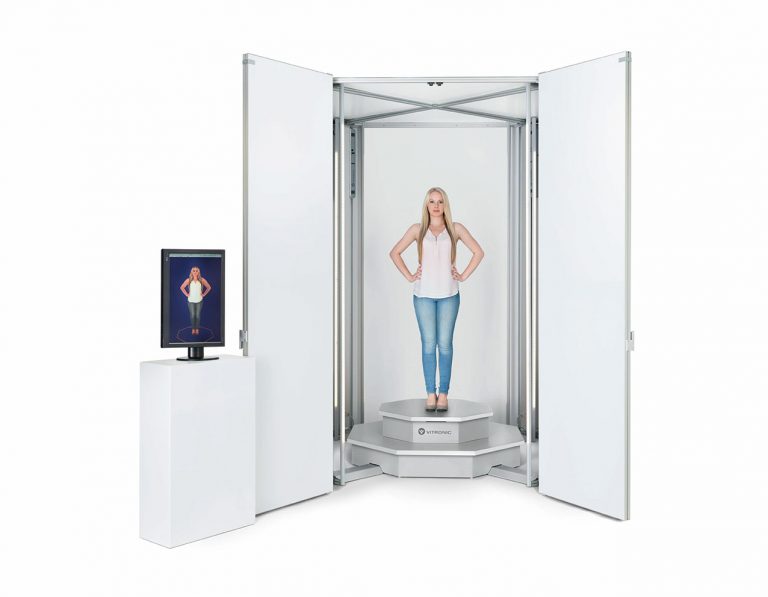
Read more application cases
Reverse engineering
Creaform’s handheld 3D scanners and scan-to-CAD software are the tools engineers and industrial designers need to quickly and accurately generate 3D models of existing parts, assemblies and their surrounding environments for a wide range of reverse engineering workflows.
Read more application cases
Explore all of our 3D measurement applications
See more
Portable 3D scanners for the healthcare and educational sectors
Explore our 3D scanning solutions for healthcare, with our Healthcare Partner 3D scanner, and for education, with Creaform ACADEMIA.
3D scanning in healthcare
Creaform’s Healthcare Partner 3D scanner is the ideal device for healthcare and 3D scanning for body measurement, including orthotics, prosthetics, cranial scanning, podiatrics, plastic survey and more. Contrary to traditional measurement methods, such as plaster casts, our 3D scanner enables fast and highly accurate data acquisition.
Learn more
3D scanning in education
Teachers and researchers can help educate the engineers and designers of tomorrow thanks to Creaform ACADEMIA. Whether you need to teach students about metrology or conduct advanced research, our professional-grade 3D scanners are designed with educational purposes in mind.
Learn more
Creaform’s customer success stories
Find out about some of our latest customer satisfaction testimonials and learn how our clients are taking advantage of our 3D measurement technologies.
« Not only in the sport industry but in any kind of industry, when designing new products, we have to give the designers a base to work with. The HandySCAN 3D allows us go from the handmade prototype to the 3D models much faster. »
Bertrand Didier, Chief Engineer Sports division, SCOTT Sports
« After benchmarking all available measurement systems, we felt that Creaform’s products and solutions fitted best with our demanding requirements and environment, as they are less sensitive to movements during scanning. »
»
Jon Gunner, Technical Director, Koenigsegg Automotive AB
« With the MetraSCAN 3D scanner, we have a dynamic production development process with a common work basis for QC and design/construction. We can now make adjustments to components where we had not previously thought was possible before. »
Sebastian Witt, Quality control motorsport, KTM
« The automotive industry benefit highly from the MetraSCAN 3D optical CMM scanner line-up in the ability to scan in real time, get a precise image of what is going on with our parts and solve those critical quality issues. It ensures we provide good parts for our customer. »
Aaron Boyer, Global director – CAD/CAE, Flex-N-Gate
Effective and efficient 3D scanning is at your fingertips
Creaform’s continuous innovations in 3D measurement technologies gives you peace of mind knowing you are relying on proven 3D scanning solutions that get the job done.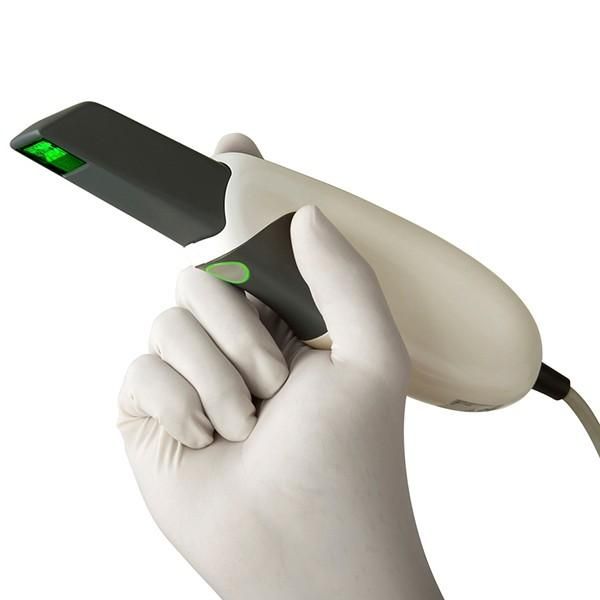
Find out how
we choose the best in 2022 in our direction
In order to expand the user audience, SHINING3D offers universal solutions - the same 3D scanner is able to satisfy the needs of ordinary consumers and be in demand in industrial production. Based on the feedback and reviews of device owners, the developers have improved the line of models, making 3D digitization and additive technologies even more accessible.
Contents:
- EinScan 3D scanners
- For beginners, designers or education
- Scanners for objects of various sizes
- 3D scanning of people and their faces
- EinScan Pro 2X 3D scanner 2020 900 Transcan0
- 3D-scanner 8 C007 indicators need to be understood in order to choose what you need
- Accuracy
- The use of professional 3D scanners in metrology
- The use of 3D scanners in mechanical engineering
- Reverse engineering
- Quality Control
- Laser 3D scanner Freescan UE
- High-precision stationary 3D scanner Autoscan Inspec
- OptimScan-5M Metrological 3D scanner 9000 EinScan Series 3D Scanners
For Beginners, Designers, or Educational EntitiesThe small-figure scanning application requires precision and advanced settings in the capture software.
 The first thing users are guided by is the scanning area. Using two models - EinScan-SP and EinScan-SE - it will be possible to scan an object from 30 × 30 mm.
The first thing users are guided by is the scanning area. Using two models - EinScan-SP and EinScan-SE - it will be possible to scan an object from 30 × 30 mm. EinScan-SP and EinScan-SE are useful for beginners, designers and educational users. Desktop scanners SE and SP are the easiest to learn.
Key benefits:
- Easy device setup with Plug and Play technology;
- Russian software interface;
- the ability to scan objects of different sizes - from small to large;
- texture tracking.
- 4-8 seconds per scan;
- Russified software;
- automatic and fixed operation;
- Aligns scanned data with marks.
- 8 seconds per scan;
- 2 minutes for 360 degree Auto Scan;
- Russified software;
- automatic alignment of multiple scans;
- API access service for 3D printers of any brand.

Scanners for objects of various sizes
aIn this category, models with the “H” index successfully demonstrated their capabilities: EinScan H , EinScan HX from the line of hybrid devices.
The portable EinScan H is the most affordable for the price.
0066
- EinScan H - an infrared emitter has been added to the LED illumination;
- EinScan HX - white LED light combined with a blue laser.
- Structured radiation of the LED source and scanner laser;
- In Laser Scan mode, the scan accuracy is 0.04 mm;
- Minimum point distance 0.05 mm;
- High efficiency in fast scan mode - 1,200,000 points/s;
- Full color copy.

- Two scanning technologies - LED and invisible infrared light, combined in one device;
- Scanning people (portrait, full-length) and other living objects;
- High accuracy of scanned data up to 0.05 mm and volumetric accuracy of 0.1 mm/m;
- Fast scanning and large FOV scanning 420*440 mm.
- A new 3D scanning principle in HD handheld mode, which allows you to scan without using markers (as Einscan Pro HD does). The old model could not scan without markers in this mode.
 The quality and detail of scans have also been improved.
The quality and detail of scans have also been improved. - Higher scanning accuracy in manual HD mode, improved volumetric accuracy for scanning large objects
- Higher scanning speed in manual HD mode
- Increased 3D scanning area hybrid alignment. This expands scanning capabilities and efficiency in a wider range of tasks and areas.
- Color Pack 3D scanning module - an additional camera that allows you to scan with color and texture;
- Industrial Pack - turntable and tripod.
 Suitable for high quality scanning of small objects in the studio.
Suitable for high quality scanning of small objects in the studio. - characteristics of the object;
- user qualification;
- scanner settings.
- the highest accuracy;
- the ability to upload scans to processing programs;
- compatible with CAD/CAM technologies;
- work with objects of various sizes and shapes, including those with complex geometry;
- texture tracking and color imaging.
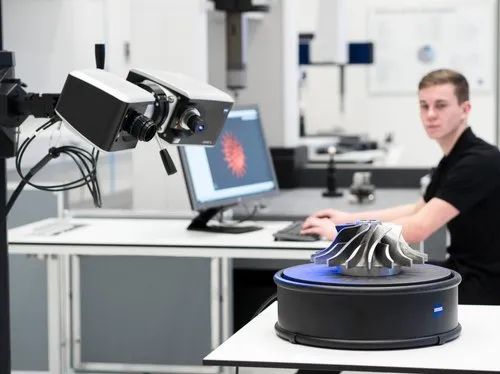
- reverse engineering;
- ultra-precise 3D quality control;
- implementation of intermediate stages of the technological chain of additive manufacturing;
- faster prototyping and other operations.
- high speed;
- ultra-precise measurement and digital copy saving;
- processing of objects regardless of the size and complexity of the form;
- possibility of integration into automated production systems.
- reverse engineering, or reverse engineering;
- metrological control;
- test measurements of geometrical parameters for the purpose of quality control and detection of defects;
- creation of archives of digital models.

- Absolutely accurate data for reference comparison;
- measurement of millions of surface points;
- high speed operation;
- possibility of automatic operation.
- user friendly interface;
- the accuracy of the 3D model reaches the metrological level with an error of 10 µm;
- the device can be used for non-contact measurement and quality control;
- the process is fully automated.

- accuracy - 15 microns;
- two 5-megapixel cameras;
- high processing speed;
- blue light scanning technology.
- Light weight, only 240g;
- Fast 3D scan, 25 sec single jaw, 1 min full arch;
- 2 tip sizes, suitable for adults and children;
- AI Scan - speed up the scanning process;
- Powerful software, ortho modeling and oral health report.
- processing speed of one jaw - 13 seconds;
- high accuracy - 7 µm;
- data export to virtual articulator;
- the ability to work with non-separable objects;
- own fully Russified Dental Scan software compatible with most CAD/CAM solutions.

- May 16, 2022 5 questions you should know...
In order to make sure that you have all the information you need to accept the application...
- Dec 17, 2021 3D Scanning Technology Fix...
This is where the police take photos of the crime scene and determine the location.
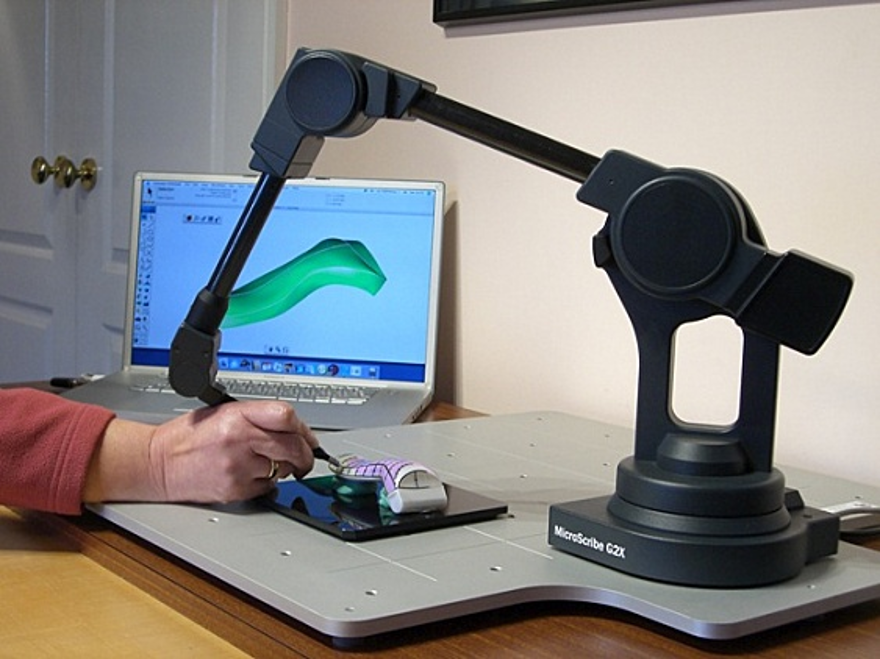
Learn more
This high-tech solution makes it possible to use these two professional scanners. Manual mode allows you to scan objects of different sizes - medium and large.
Photo of a 3d scanner EinScan HXCopying accuracy is so great that when scanning works of art, it is possible to obtain a perfect replica. For medical institutions, this is also a worthy find. Separately, it should be noted the presence of a built-in color camera.
3D scanning of people and their faces
Living objects require special scanning technology. You can get a digital copy of a fragment of a human body, face and hair using EinScan H hybrid models - thanks to two light sources and a color camera, they produce an ideal 3D model with texture preservation.
HX is a universal model, and Einscan Pro HD/Einscan pro 2x 2020 are multifunctional scanners, have the ability to perform tasks in various industries.
EinScan Pro HD is an upgrade from the older model of the Einscan Pro 2x series due to its ergonomic and high quality design. Models in this range can be used with a special tripod.
This professional 3D scanner provides high scanning accuracy in both operating modes: up to 0.045+0.3 mm/m.p. in manual mode and up to 0.04 mm. in fixed scan mode.
Manual mode has two sub-modes: Rapid and HD, the latter providing a higher level of detail.
The maximum possible speed of this scanner is 3 million points per second. Even aside from the specs, you can see that the device is extremely fast in real-life scenarios. For example, a 220 x 71 cm low relief sculpture can be fully digitized in color in less than a minute.
Scanning of human bodies is also possible with this device, it provides decent quality. Last but not least, the device can scan color materials, including even textured images. This feature is available as a paid option called the Color Pack.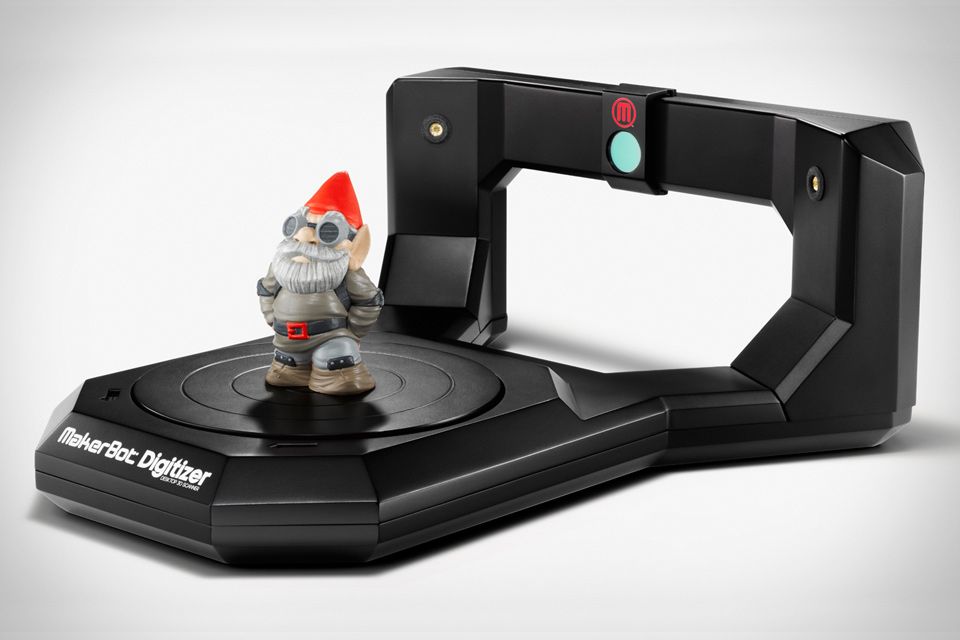
EinScan HX is more expensive than EinScan H, and professional scanners, which include EinScan Pro HD, are traditionally more expensive than other "classmates" and therefore available to large additive manufacturing.
EinScan Pro 2X 2020 3D Scanner
Portable and versatile handheld 3D scanner for high precision results
The EinScan Pro 2X 2020 3D scanner is an excellent option for scanning small, medium and large objects.
3D scanner EinScan Pro 2X 2020The updated model has improved the main characteristics, added new 3D scanning algorithms. Thus, Einscan Pro 2x 2020 has become a more affordable version of Einscan Pro HD, retaining the advantages and features of the old model.
The main improvements of the new model:
Einscan Pro 2x 2020 is compact and lightweight, you can take it anywhere with you. It has a comfortable grip and is light weight, and if you need HD mode accuracy, put the scanner on a tripod. The scanner is connected via USB 3.0 to a computer or laptop.
The latest developments in data capture and optimized algorithms make the Einscan Pro 2x 2020 3D Scanner a true breakthrough with a scanning speed of up to 1,500,000 points per second (at 30 frames per second) in manual scanning mode.
If you need to expand the functionality of the scanner, Shining 3D offers several options:
Transcan C
3D ScannerThe professional-grade Transcan C 3D Scanner is capable of capturing “superiorly” accurate, high-resolution scans of small to medium objects thanks to two 12-megapixel color cameras with adjustable scan range and multi-level switching permits within a single project.
The 3D scanner has a sliding design that allows you to easily switch the scanning range between 150mm x 96mm and 300mm x 190mm to suit different sizes of objects. The multi-resolution fusion algorithm allows you to mix high, medium and low resolutions in the same project, making the scanner much more efficient, and its two cameras can capture a 24-bit color map for detailed 3D color data.
The Transcan C features a structured light scanning mode with an automatic turntable that, in combination with the scanning software's stitching algorithm, allows “efficient 3D model acquisition without manual intervention.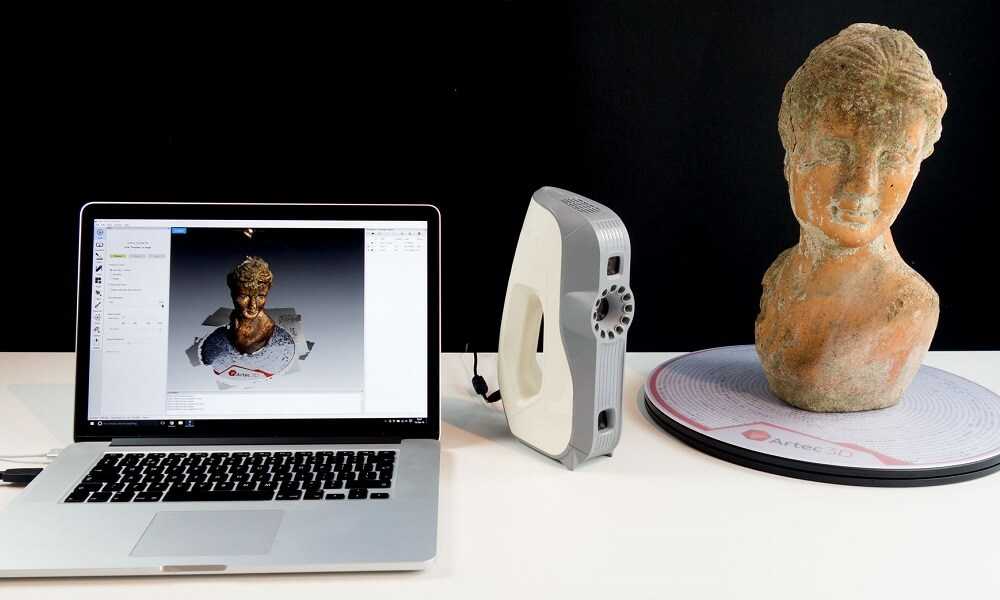
What other indicators do you need to understand in order to choose what you need? - ease of setup and others. Of course, the properties are considered in a complex: the most important parameter is considered as a basic one, the rest are considered as auxiliary, but at the same time mandatory.
3D Scan Accuracy
The degree to which the copy matches the original is perhaps the most important indicator. The technical characteristics of scanners indicate the maximum allowable deviation of the scan size from the real object. The smaller the number, the more accurate the 3D scan will be. But the deviation in reality can be greater, since it is quite difficult to create ideal conditions for the device to work, the result is affected by:
The use of professional 3D scanners in metrology
3D scanners handle the process of measuring the dimensions and shapes of models in a matter of minutes, unlike traditional coordinate measuring machines. The non-contact mode of operation makes it possible to scan surfaces of complex shapes (internal corners and edges), recesses and other hard-to-reach places.
The non-contact mode of operation makes it possible to scan surfaces of complex shapes (internal corners and edges), recesses and other hard-to-reach places.
After receiving all the necessary data, they are transferred to the computer for processing. The program performs a comparison of indicators in order to identify deviations - a mismatch in shape and size, the presence of chips, cracks and other deformations caused by mechanical stress or corrosion processes.
Innovatively adapted blue laser 3D scanning technology
For metrology purposes for scanning a small object, we recommend the OptimScan-5M, 3M and AutoScan Inspec Scanner-Inspector. All these devices to some extent belong to the same price niche, are multi-tasking, make it possible to obtain high-quality digital 3D models for comparison with reference samples, demonstrating:
Professional, they are also industrial, 3D scanners help to perform the following tasks:
3D scanning in mechanical engineering
The integration of 3D scanning technologies into production processes gives undoubted preferences. Properties of modern industrial devices:
With the help of 3D scanners and specialized software, numerous processes can be performed:
Reverse engineering
Reverse engineering of complex shapes is one of the areas of industrial engineering. A physical sample is converted into a digital copy using a 3D scanner. The resulting polygonal model is converted into a CAD format. The digital copy is modified and modified to achieve the specified parameters. Unlike traditional design, work takes many times less working time. The finished object becomes the basis for mass production.
Quality control
Metrological 3D scanners make it possible to obtain a point cloud of the test sample, on the basis of which an ultra-precise 3D model of the part is formed. It is compared with a digital copy of a reference sample or with an existing CAD model.
Benefits of 3D quality control:
The obtained data can be used for reverse engineering.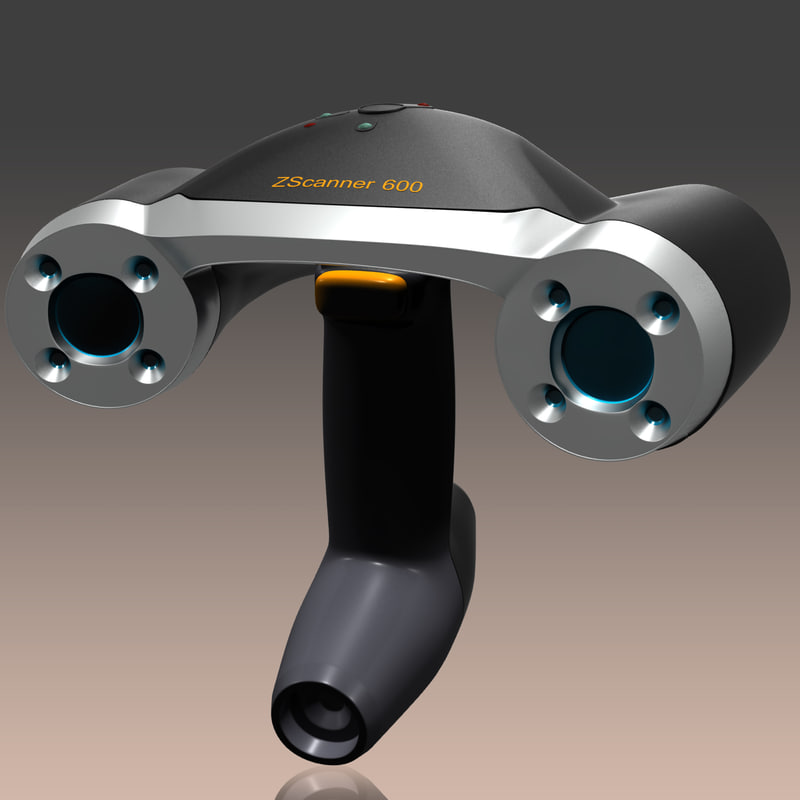
Scanners from the metrological category are recommended for quality control.
FreeScan UE
Shining 3D Handheld Laser Scanner FreeScan UE is the latest addition to the FreeScan high performance 3D scanner line. The device uses the patented blue laser technology and features high accuracy and stable repeatability.
Sunny Wong, product manager of Shining 3D, states: “Innovative adaptation of blue laser 3D scanning technology, high precision and stable repeatability, and easy and convenient operation of hardware and software, enable FreeScan UE to efficiently and accurately upgrade digital workflows in engineering and inspection tasks”.
The metrology-grade FreeScan UE system delivers 0.02 mm accuracy and 0.02 mm + 0.04 mm/m volumetric accuracy. With a maximum scan area of 510 x 520mm, users get a field of view suitable for large-scale reverse engineering projects.
AutoScan Inspec High Accuracy Stationary 3D Scanner AutoScan Inspec
Works with native software developed by SHINING 3D programmers for industrial applications.
OptimScan-5M 3D metrological scanner
OptimScan-5MThe professional 3D metrological scanner OptimScan-5M shows the best consumer characteristics required just for 3D inspection:
Desktop AutoScan Inspec is a two-in-one scanner-inspector that works in automatic mode. The scanner performs 3D scanning with the highest precision and 3D inspection of objects. This is one of the best devices for working with parts of complex shape and the smallest elements:
Solutions for dentistry
In dental orthopedics, 3D scanners - intraoral and dental - have become indispensable assistants for orthopedists and dental laboratory specialists. The former are used to create digital impressions and then produce perfectly fitted dentures, crowns, veneers and other dental restorations using a 3D model using CAD/CAM technology.![]() The second digitizes plaster casts or abutments with tiny elements.
The second digitizes plaster casts or abutments with tiny elements.
Aoralscan 3
The Aoralscan 3 is a compact, powerful device with simple, user-friendly controls and an updated algorithm:
AutoScan-DS-MIX 3D Dental Scanner
AutoScan-DS-MIXAutoScan-DS-MIX is an exceptional performance dental scanner with two 5 megapixel cameras and advanced blue light 3D scanning technology :
SHINING 3D's 3D modeling and additive manufacturing products make it easy to find the right equipment for solving tasks in industry, medicine, education and everyday life.
Company's professional 3D scanners│The best solution for 3D scanning
Find the perfect 3D scanner
SIMSCAN 3D Scanner
Portable, lightweight and handheld 3D scanner provides high precision 3D scanning without any work environment limitation.
Read more
AutoScan-K 3D System
The AutoScan-K 3D Scanning System is designed for automated batch inspection on the shop floor.
Read more
3D Scanner TrackScan
3D scanner based on optical tracking measurement technology, well suited for high-precision measurement of large-scale products without marks.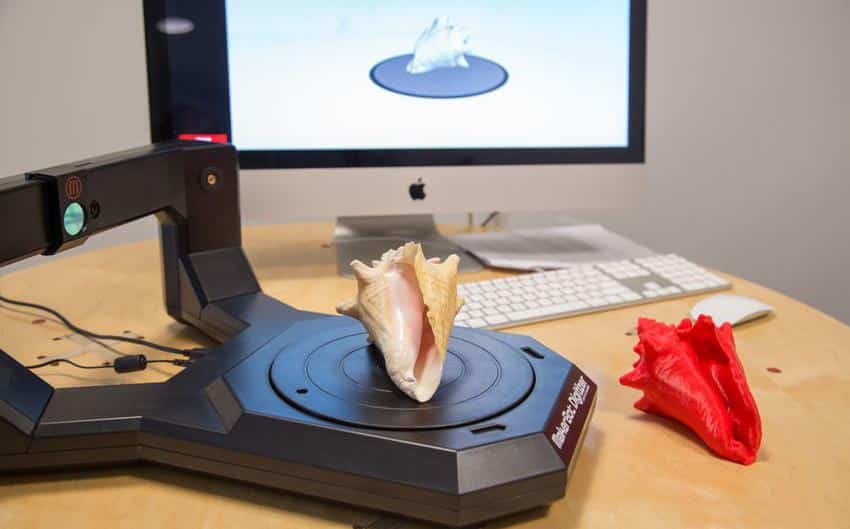
Read more
KSCAN Composite 3D Scanner
Metrology-grade combo 3D scanner with infrared and blue lasers provides unparalleled scanning speed, accuracy and detail.
Read more
Scantech 3D software
Free and powerful 3D ScanViewer software provides various inspection and scanning features to streamline your workflow
Learn more
Which 3D solution is best for my business?
Promote your business with 3D digital technology
ask the expert
KSCAN-Magic 3D Scanner
Experience a variety of top performance from metrological measurement
AutoScan-T42 3D system
Automated Optical Inspection for Intelligent Production Line
AutoScan-K 3D system
Automated Inspection System with High Safety and Efficiency
iReal 2E 3D Scanner
Expanded field of view ensures comfortable and smooth operationWant to become a dealer?
Distribute special handheld 3D scanners worldwide
Join us
News
Read more
About us
SCANTECH is one of the first high-tech companies to research and develop handheld 3D scanners.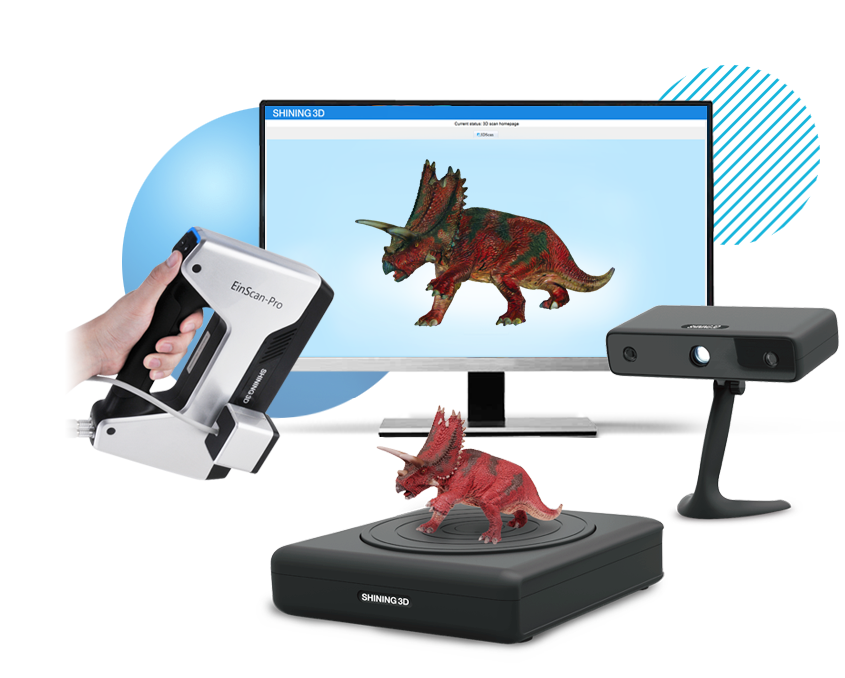 Using its great technical capability, SCANTECH has formed strategic partnerships with several world-class companies. We have set up joint research and development centers, and made plans for joint development. Our products are sold to more than 50 countries and regions in the world, serving more than 5,000 enterprises such as Boeing, NASA, COMAC, BMW, Volkswagen, GM, Apple, Siemens, JCB and Sany.
Using its great technical capability, SCANTECH has formed strategic partnerships with several world-class companies. We have set up joint research and development centers, and made plans for joint development. Our products are sold to more than 50 countries and regions in the world, serving more than 5,000 enterprises such as Boeing, NASA, COMAC, BMW, Volkswagen, GM, Apple, Siemens, JCB and Sany.
Read more


